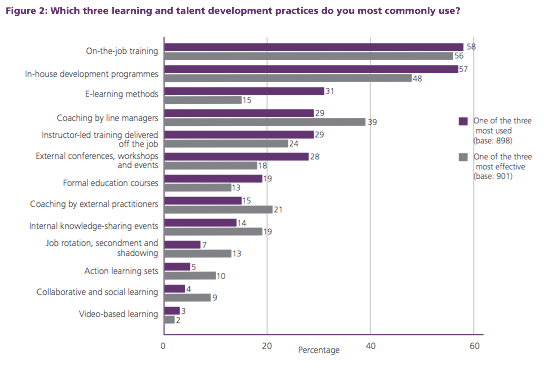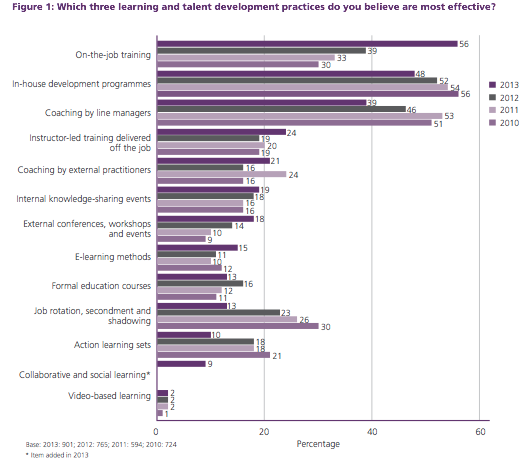The latest CIPD learning and talent development report reveals the latest trends in workplace learning and in particular the types of learning interventions that are currently favoured by employers. Here we summarise the key trends.
 Trends in learning and talent development
Trends in learning and talent development
On-the-job training, in-house development programmes and coaching by line managers continue to be the most effective form of learning delivery (see diagram). On-the-job training is seen as increasingly effective. Coaching is in decline and elearning continues to be relatively ineffective.
E-learning, collaborative and social learning
The proportion of organisations using e-learning (74%) has not changed significantly from 2011. It is, however, being offered to an increasing proportion of employees within those organisations. Only 31% of employees complete courses.
E-learning is seen as more effective when combined with other types of learning and nearly three-quarters agree it is not a substitute for face-to-face or classroom learning. Nearly three- quarters believe e-learning is essential in today’s collaborative and networked learning and three-fifths that it is a very effective method of supporting learning in the organisation.
‘Social learning’ is understood in a variety of ways. More than two-thirds include group webinars and mentoring/peer-to-peer learning in their definition of social learning and nearly as many consider learning around the water cooler to be social learning. Half consider learning on the job to be social learning, while just a third included using collaborative platforms such as Jive or Salesforce chatter or online forums as social learning. One in seven organisations remains unsure about the influence of social learning on employee development.
Leadership development
Most organisations will conduct leadership development activities in the next 12 months.The most common focus will be in improving the skills of leaders to think in a more strategic and future-focused way (50%). Other common objectives will include enabling the achievement of the organisation’s strategic goals, developing high- potential individuals valued by the organisation and producing a common standard of behaviour for those in leadership roles.
The research revealed leaders lacked the following skills: performance management, change management, people management and coaching/ mentoring/developing staff.
Onboarding
Some 96% of organisations conduct employee orientation activities for new starters, although one in five report their organisation and senior employees are not committed to onboarding. Activities typically include: an introduction of the company and its background, a tour of the office and job-specific and health and safety training. Approximately two-fifths provide office buddies and pre-onboarding activities and a quarter offer team lunches.
Assessing the impact of learning and talent development activity
Most respondents say they assess the impact of learning and talent development activity in some way. The frequency and methods used vary. Nearly three-quarters of respondents have encountered difficulties in testing or measuring the effectiveness of L&D activities. The most common problems reported include lack of priority given to measuring L&D effectiveness by managers and leaders and consistent access to required data.
Training spend
Only 8% of respondents say their organisations’ economic circumstances have improved over the past 12 months. Two-thirds of public sector organisations say their funding situation has got worse over the last year. Half of the public sector and a quarter of the private report resources and funds have declined over the past year. Nearly half of the public sector have also seen reductions in headcount.
The median annual training budget per employee was £303 (2012: £276; 2011: £350), but this masked considerable variation within and across sectors. As in previous years the median training budget per employee was lowest in the public sector. The median number of training hours employees receive per year was 25, similar to last year (24), with no significant differences across sectors.
- Read the full report here.





